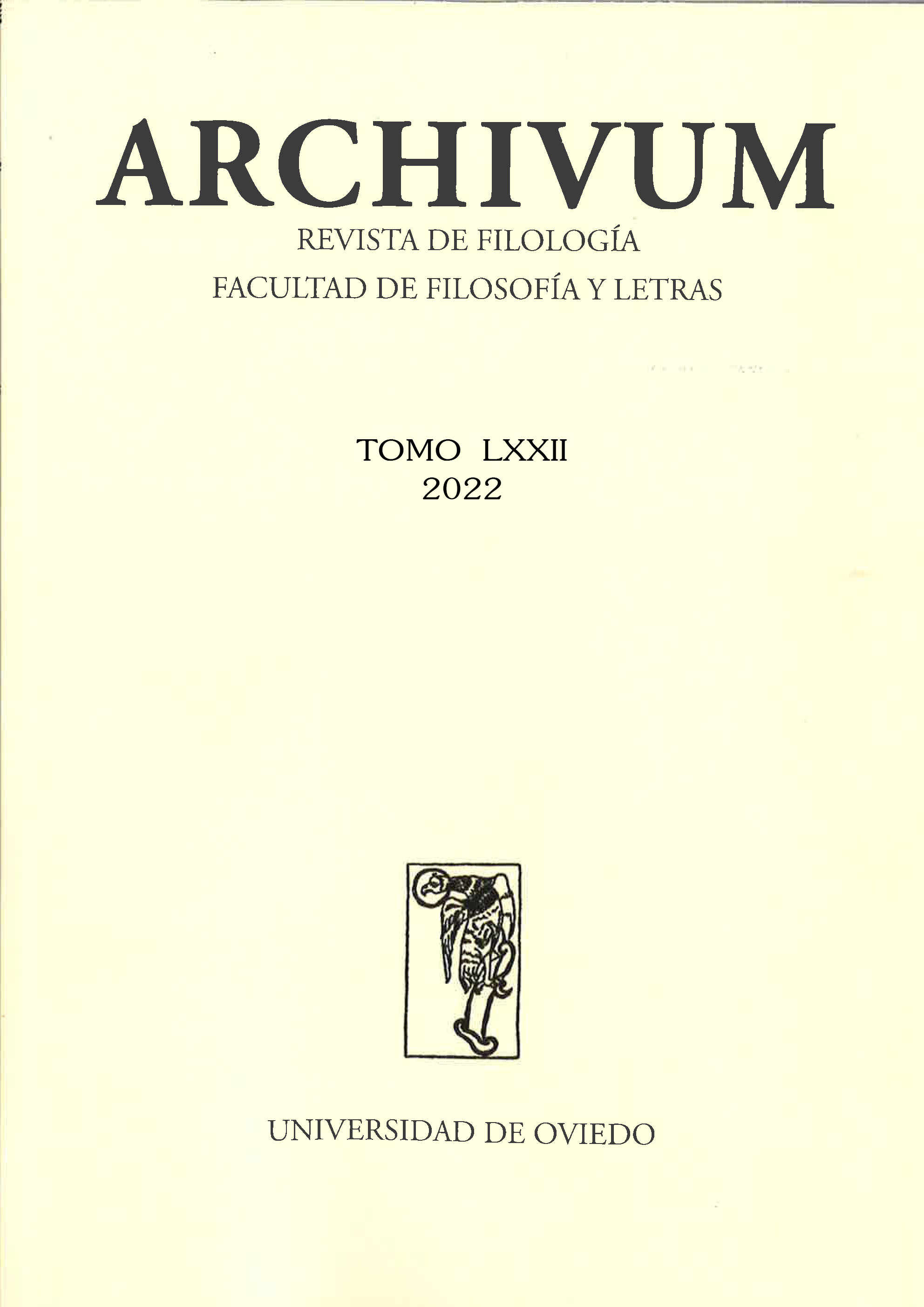Abstract
This article sets to analyze the dramas Julius von Tarent by Johann Anton Leisewitz and Die Zwilinge by Friedrich Maximilian Klinger, both published in 1776 and exponents of the drama of the Sturm und Drang. It will study the motivations of the characters and the reinterpretations that each work offers of the fratricide of Cain and Abel: in Leisewitz, Julius cannot unite the spheres of reason of State and love, so he decides to rebel against the former and try to flee, but Guido prevents him and ends up murdering him; in Klinger, Guelfo questions Ferdinando’s birthright and claims it for himself, considering that it has been stolen and given everything to his brother. Through the actions of the characters in both dramas, the machinery of subordination and exercise of power that operates in them becomes visible. It is concluded that the works should not be seen as revolutionary dramas, but that in them operates an incipient critique of the enlightenment postulates and shows the decadence and imminent collapse of a society/family too rigid and hypocritical that seeks only its preservation and continuity without considering the internal consequences, i.e., the fragmentation and polarization that they may cause.
References
Adorno, Th. W. (1997) Gesammelte Schriften 7: Ästhetische Theorie. Tiedemann, R. (ed.). Frankfurt am Main: Suhrkamp.
Allan, S. (2004) “Hat nicht alles den Stachel zur Rache? Gender, class and revenge in J.A. Leisewitz’s Julius von Tarent and F.M. Klinger Die Zwillinge”, Colloquia Germanica, 37(2), pp. 109-128.
Aristóteles (2018) Poética de Aristóteles. Edición trilingüe. García Yebra, V. (trad.). Madrid: Gredos.
Arndt, A. (2001) “Galora von Venedig. Ein Trauerspiel in fünf Aufzügen, von Traugott Benjamin Berger. Leipzig 1778”, en Hollmer, H. / Meier, A. (eds.). Dramenlexikon des 18. Jahrhunderts. München: C. H. Beck, pp. 25-26.
Aurnhammer, A. (2008) “Berger, Traugott Benjamin”, en Kühlmann, W. (ed.). Killy Literaturlexikon. Autoren und Werke des deutschsprachigen Kulturraumes. Berlin/New York: De Gruyter, p. 466.
Frenzel, E. (2015) Motive der Weltliteratur. Stuttgart: Kröner.
Gray, R. T. (1986) “The Ambivalence of Revolt in Klinger’s Zwillinge: An Apologia for Political Inconsequence?”, Colloquia Germanica, 19 (3), pp. 203-228.
Guthke, K. S. (1970) “F. M. Klingers Zwillinge: Höhepunkt und Krise des Sturm und Drang”, The German Quarterly, 43(4), pp. 703-714.
Karthaus, U. (2012) “Johann Anton Leisewitz: Julius von Tarent”, en Dramen des Sturm und Drang. Stuttgart: Reclam, pp. 99-128.
Keller, W. (1995) “Nachwort”, en Johann Anton Leisewitz: Julius von Tarent. Stuttgart: Reclam, pp. 77-117.
Kirby, M. (1983) “Julius von Tarent and the Theme of Fraternal Strife in the Sturm und Drang”, Forum for Modern Language Studies, 19(4), pp. 348-363.
Klinger, F. M. (1997) Die Zwillinge. Paralleldruck der Ausgaben von 1776 und 1794. Harris, E. P. / Haack, E. / Hartmann, K.H. (eds.). Tübingen: Max Niemeyer.
Leisewitz, J. A. (1838) Sämmtliche Schriften von Joh. Anton Leisewitz. Zum erstenmale vollständig gesammelt und mit einer Lebensbeschreibung des Autors eingeleitet. Braunschweig: Eduard Leibrock.
Leisewitz, J. A. (2012) Julius von Tarent. Keller, W. (ed.). Stuttgart: Reclam.
Lessing, G. E. (1985) Hamburgische Dramaturgie, Werke und Briefe 6. Bohnen, K. (ed.). Frankfurt am Main: Deutscher Klassiker Verlag.
Luserke-Jaqui, M. (2010) Sturm und Drang. Stuttgart: Reclam.
Luserke-Jaqui, M. (2017a) “Einleitung – Sturm und Drang. Genealogie einer literaturgeschichtlichen Periode”, en Luserke-Jaqui, M. (ed.). Handbuch Sturm und Drang. Berlin/Boston: De Gruyter, pp. 1-28.
Luserke-Jaqui, M. (2017b) “Julius von Tarent”, en Luserke-Jaqui, M. (ed.). Handbuch Sturm und Drang. Berlin/Boston: De Gruyter, pp. 469-473.
Martini, F. (1972) “Die feindlichen Brüder: zum Problem des gesellschaftskritischen Dramas von J.A. Leisewitz, F.M. Klinger und F. Schiller”, Jahrbuch der deutschen Schillergesellschaft, 16, pp. 208-265.
Matt, P. von (1995) Verkommene Söhne, mißratene Töchter. Familiendesaster in der Literatur. München: Hanser.
Mattenklott, G. (1968) Melancholie in der Dramatik des Sturm und Drang. Stuttgart: Metzler.
Meyer-Kalkus, R. (1998) “Die Rückkehr des grausamen Todes. Sterbeszenen im deutschen Drama des 18. Jahrhunderts”, Zeitschrift für Religions- und Geistesgeschichte, 50(2), pp. 97-114.
Poeplau, A. (2012) Selbstbehauptung und Tugendheroismus. Das dramatische Werk Friedrich Maximilian Klingers zwischen Sturm und Drang und Spätaufklärung. Würzburg: Königshausen & Neumann.
Port, U. (2005) Pathosformeln. Die Tragödie und die Geschichte exaltierter Affekte (1755-1888). München: Wilhelm Fink.
Rousseau, J.-J. (1996) Discours sur les sciences et les arts. Bouchardy, F. (ed.). Paris: Gallimard.
Schonlau, A. (2017) Emotionen im Dramentext. Eine methodische Grundlegung mit exemplarischer Analyse zu Neid und Intrige 1750–1800. Berlin/Boston: De Gruyter.
Schöpfin, K. (2011) Die Bibel in der Weltliteratur. Tübingen: Mohr Siebeck.
Schröder, F. L. (1776) Hamburgisches Theater. Band 1. Hamburg: Bode.
Smoljan, O. (1962) Friedrich Maximilian Klinger: Leben und Werk. Arndt, E. M. (trad.). Weimar: Arion.
Wenzel, S. (1993) Das Motiv der feindlichen Brüder im Drama des Sturm und Drang. Frankfurt am Main: Peter Lang.
Wuthenow, R.-R. (1978) “Rousseau im Sturm und Drang”, en Hinck, W. (ed.). Sturm und Drang. Ein literaturwissenschaftliches Studienbuch. Frankfurt am Main: Athenäum, pp. 14-53.

This work is licensed under a Creative Commons Attribution-NonCommercial-NoDerivatives 4.0 International License.

